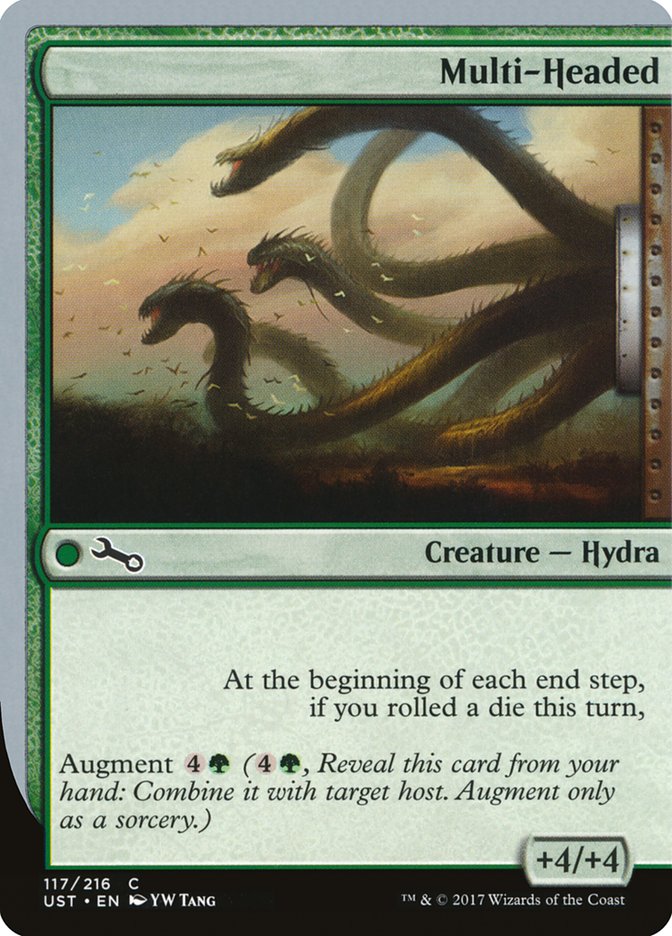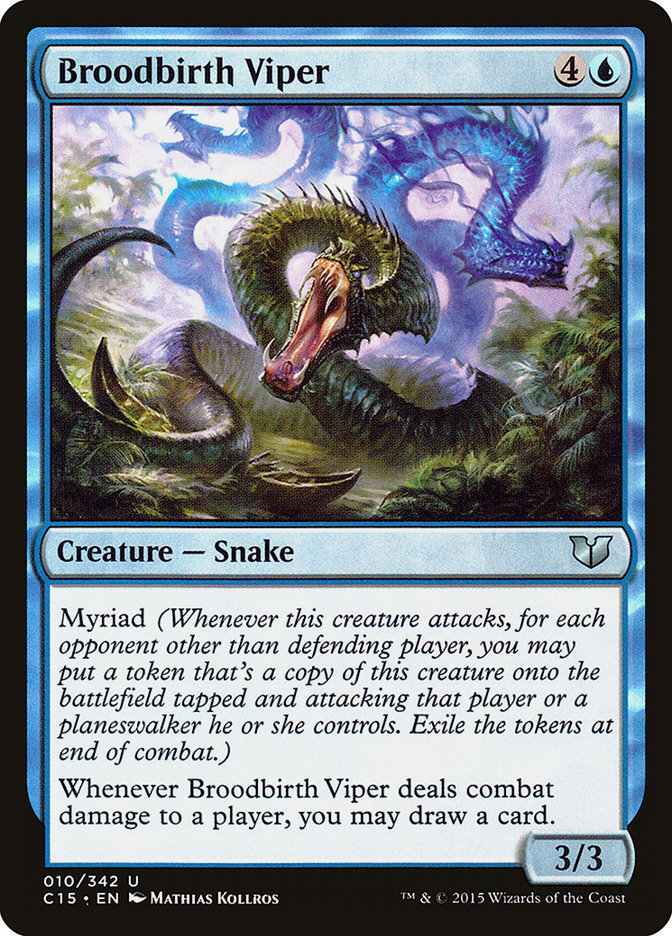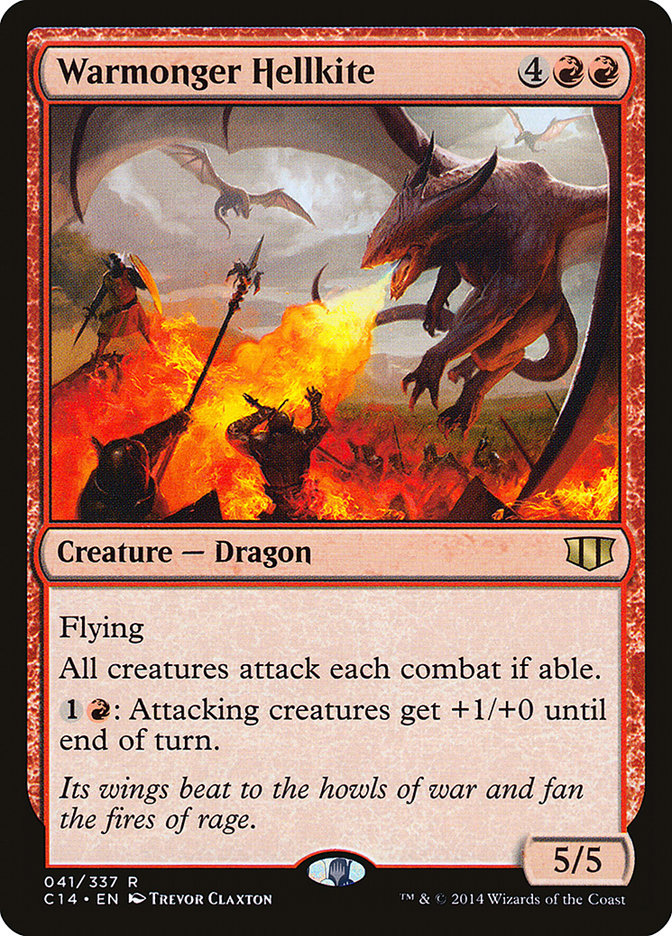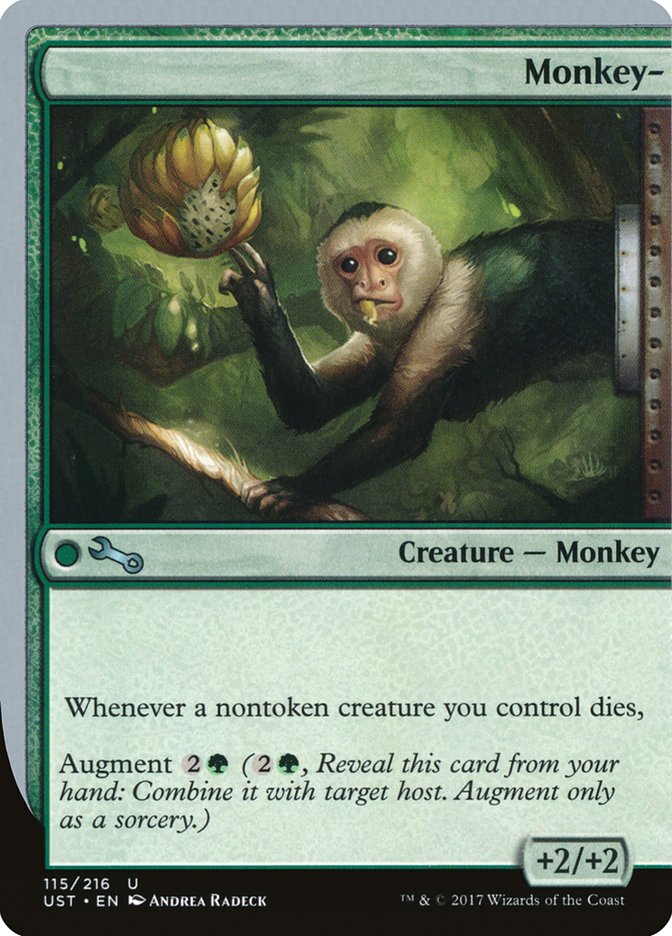Multi-Headed MTG Card
Text of card
At the beginning of each end step, if you rolled a die this turn, Augment (, Reveal this card from your hand: Combine it with target host. Augment only as a sorcery.)
Cards like Multi-Headed
Exploring the realm of Magic: The Gathering, the Multi-Headed card offers players a unique tactical edge. It follows in the footsteps of cards like Hydra Omnivore, which shares the ability to deliver damage to multiple opponents. Both cards shine in multiplayer formats, where board influence becomes crucial. However, the Multi-Headed card stands out with its potential for exponential damage growth under the right conditions.
Another peer in this category is the Broodbirth Viper, which, similar to Multi-Headed, can affect all opponents. While not directly dealing damage, it multiplies its presence by creating tokens with Myriad. This creates a wide array of threats across the board. One should also consider the classic Warmonger Hellkite. It forces all creatures to attack each turn if able, spreading damage across the game but without the targeted efficiency of the Multi-Headed card.
Ultimately, the Multi-Headed card occupies its niche within Magic: The Gathering. It capitalizes on its unique interactive mechanics that set it apart from other creatures that focus on singular or wide-reaching effects. Its strengths lie in the ability to strategically dictate the flow of multiplayer games.
Cards similar to Multi-Headed by color, type and mana cost
Card Pros
Card Advantage: The allure of a multi-headed card is often found in its inherent ability to give players more options and potential for card advantage. With each head providing a different effect or ability, players can adapt to the evolving game state more readily, having access to more actions or responses within a single card.
Resource Acceleration: Many multi-headed cards are designed to escalate your resources on the battlefield. Whether they produce additional mana, tokens, or other forms of in-game currency, they serve to thrust you ahead in the resource race, setting up for powerful plays earlier than usual.
Instant Speed: Instant speed interaction is where multi-headed cards can really shine. Having the flexibility to respond to an opponent’s move with a multi-faceted card can sway the momentum of the game. The ability to choose between multiple effects at instant speed adds layers of strategy, allowing for surprise factor and adaptability during critical game moments.
Card Cons
Discard Requirement: When playing a multi-headed card, you may have to discard one or more cards from your hand. This requirement can serve as a serious setback, especially when your hand is your last line of defense and every card counts towards formulating a winning strategy.
Specific Mana Cost: Multi-headed cards often come with a unique mana cost that requires a diverse mana base. This specific need can pose a challenge if you’re running a mono-colored deck or if your mana sources are limited, potentially causing delays in getting these powerful creatures onto the battlefield when you need them most.
Comparatively High Mana Cost: The robust abilities of multi-headed creatures usually come at a steep price. Their mana costs are higher compared to single-headed counterparts. This difference often means that they hit the play later in the game, which could be too late if your opponent has already established a strong presence or has answers to your threats.
Reasons to Include in Your Collection
Versatility: Multi-Headed cards can adapt to various deck themes, particularly when agility is key. Their capacity to tackle numerous threats at once makes them solid choices in a diverse array of strategies.
Combo Potential: These cards excel in synergizing with effects that are triggered by dealing damage, controlling multiple creatures, or playing spells with certain traits. They open up avenues for intricate interactions and synergistic deck-building.
Meta-Relevance: Given their inherent ability to pressure opponents on different fronts, Multi-Headed cards can be crucial when facing decks that spread out threats or use swarm tactics. Their utility in the current competitive landscape can give players a much-needed edge.
How to beat
Tackling a Multi-Headed MTG card can be an intriguing challenge on the battlefield. Cards with this term generally refer to those featuring multiple creatures or effects rolled into one, leading to a richer tactical gameplay. When facing such cards, it’s vital to strategize your removal spells or effects to maximize efficiency. Cards like Supreme Verdict that can wipe the board clean are incredibly effective, as they bypass any indestructible traits a Multi-Headed creature might possess.
Another strategy is to employ targeted exile effects, such as Path to Exile or Swords to Plowshares, to permanently remove problematic creature heads from the game. Additionally, making use of control elements, including counter spells and hand disruption tactics, can prevent these powerful cards from hitting the table in the first place. For a more direct approach, mass damage spells or those that distribute multiple damage points, like Chain Lightning or Blasphemous Act, can reduce the Multi-Headed threat one head at a time.
Understanding your deck’s capabilities and preparing answers for formidable Multi-Headed cards can fortify your defense. Whether it’s through board wipes, efficient removal, or pre-emptive disruption, these strategies can ensure your victory against the challenging Multi-Headed monsters lurking across various MTG sets.
Where to buy
If you're looking to purchase Multi-Headed MTG card by a specific set like Unstable and Jumpstart 2022 Front Cards, there are several reliable options to consider. One of the primary sources is your local game store, where you can often find booster packs, individual cards, and preconstructed decks from current and some past sets. They often offer the added benefit of a community where you can trade with other players.
For a broader inventory, particularly of older sets, online marketplaces like TCGPlayer, Card Kingdom and Card Market offer extensive selections and allow you to search for cards from specific sets. Larger e-commerce platforms like eBay and Amazon also have listings from various sellers, which can be a good place to look for sealed product and rare finds.
Additionally, Magic’s official site often has a store locator and retailer lists for finding Wizards of the Coast licensed products. Remember to check for authenticity and the condition of the cards when purchasing, especially from individual sellers on larger marketplaces.
Below is a list of some store websites where you can buy the Multi-Headed and other MTG cards:
 BUY NOW
BUY NOW BurnMana is an official partner of TCGPlayer
- eBay
- Card Kingdom
- Card Market
- Star City Games
- CoolStuffInc
- MTG Mint Card
- Hareruya
- Troll and Toad
- ABU Games
- Card Hoarder Magic Online
- MTGO Traders Magic Online
See MTG Products
Printings
The Multi-Headed Magic the Gathering card was released in 2 different sets between 2017-12-08 and 2022-12-03. Illustrated by 2 different artists.
| # | Released | Name | Code | Symbol | Number | Frame | Layout | Border | Artist |
|---|---|---|---|---|---|---|---|---|---|
| 1 | 2017-12-08 | Unstable | UST | 117 | 2015 | Augment | Silver | YW Tang | |
| 2 | 2022-12-03 | Jumpstart 2022 Front Cards | FJ22 | 43 | 2015 | Token | Black | Eric Deschamps |
Rules and information
The reference guide for Magic: The Gathering Multi-Headed card rulings provides official rulings, any errata issued, as well as a record of all the functional modifications that have occurred.
| Date | Text |
|---|---|
| 2018-01-19 | Augment can (and usually does) change the name, card types, subtypes, rules text, and power/toughness. The combined creature will have (at least) two artists and may now have multiple colors. Anything covered up in the augment process doesn’t count, so ignore things to the left of the “metal bar” in the art of host creatures. |
| 2018-01-19 | Augment can’t target creatures that aren’t host creatures. |
| 2018-01-19 | Augment is an activated ability that you activate from your hand. To do so, reveal the card, choose a target host creature, and pay the augment cost. As this ability resolves, if the card with augment is still in your hand, put it onto the battlefield combined with the host creature. |
| 2018-01-19 | Creatures with augment don’t have a mana cost and can’t be cast. |
| 2018-01-19 | The creature card with augment isn’t put onto the battlefield until the ability resolves. This means if the host is destroyed, the creature with augment stays in your hand. You can’t choose a different host, but you can activate augment again if there’s another host available. |
| 2018-01-19 | You can’t activate augment unless there is a host creature on the battlefield. It doesn’t need to be yours. Note though that if you augment another player’s host creature, they control the combined creature. |
| 2018-01-19 | You can’t put more than one augment card on a single host creature. Once a host creature is augmented, the host part gets covered up and it’s no longer a host creature. |







